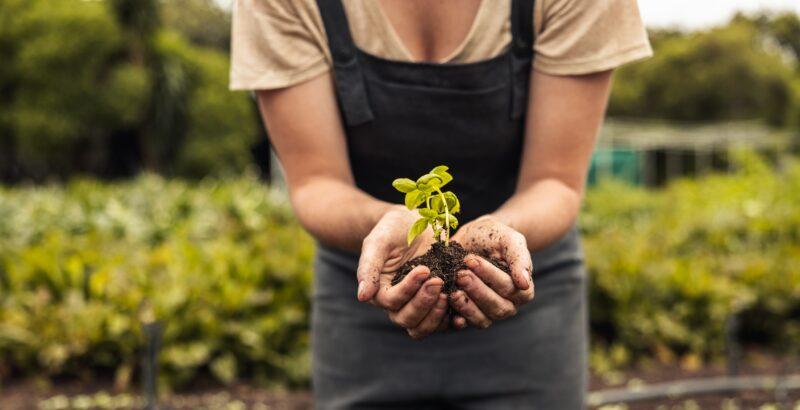A short bike ride from my house are fields of corn and soybeans that are beginning to grow now and continuing to grow throughout the summer. The work of plowing fields and planting seeds is ever-present in the spring.
What you don’t see are farmers standing in their fields screaming at their seeds. After planting seeds, they’re not micromanaging the germination process. Farmers know with the right conditions the seed is capable of germinating and growing on its own.
The farmer trusts that the seed knows what to do.
This metaphor of trust holds many lessons for team development, leadership practices, and even life itself. In fact, I’ve been noticing the colossal role trust plays in our lives. We often act, almost unconsciously, based on an assumed trust.
Given ample fuel and regular maintenance checks, I trust my car will run. I trust a server in the restaurant will bring me the food I ordered. I trust the plane and the team responsible for guiding it will get me to my destination. (Although, with recent news, I may be a little less confident about this last example.)
Trust weaves our communities together in many ways. Yet conversely, we’ve come to make certain assumptions about who or what not to trust. Within systems based on control and command, these lessons and assumptions can be quite damaging.
? What would happen if we trusted our employees like a farmer trusts the seed?
All transformational change flows through relationships at the speed of trust. The depth and quality of trust in an organization either accelerates the desired impact – or hinders our higher purpose.
When trust is an essential part of our organizations and our teams, many things change. This change occurs more rapidly when we genuinely trust that, like the seed, our employees know what to do.
Questions on Trust
We’ve all had the experience when the solution suddenly pops into our heads. That’s the beauty of standing in inquiry, practicing curiosity instead of judgment.
If you’ve read my blogs, you probably know I love good questions. When we ask good questions without a sense of urgency to get the “right” answer, the question becomes a passenger in our workday journey. It attracts our attention and energy in a positive way. We continue to carry the question, often subconsciously, until we have discovered our answer.
Let’s envision your organization if the seed-like trust were present. I invite you to let the following questions travel with you over the next week to see what emerges.
- What would it look like if employees were fully trusted?
- What would we spend time on?
- What would we not spend time on?
- How would our behavior change?
- How would this shape our leadership practices?
An Exercise to Reflect on Trust
Nature is designed to create conditions conducive to the lives of future generations. Based on this framework, we learn from Nature that we don’t have to direct the development of trust. Instead, like the farmer, we must create conditions conducive to developing trust in our teams and organizations.
When learning how to create conditions that build more trust, it’s helpful to begin by examining situations where distrust exists. Have you been a part of a team, department, or division where people didn’t trust each other? In thinking of that experience, what kind of leadership shaped the condition of distrust? What were the organizational values, behaviors, and norms that diminished – or eliminated trust?
Often, these frameworks are based on a zero-sum, win-lose framework. This makes trust difficult to “grow” as self-interest and competition are the primary values. There is a belief that others are antagonists to our ability to get what we want. In this type of environment, trust is antithetical to the organization’s culture.
Now, try to think of a group or organization where people trusted each other. Ask the same questions as before to understand the leadership, values, behaviors, and norms that influenced and nurtured the presence and acceleration of trust. As before, determine what those organizational frameworks were or are based on.
Becoming a Farmer
Trust can be measured by how willing people in the organization are to share their thoughts and feelings, both in formal meetings and casual conversations. This trusting behavior exists when others behave in a trustworthy way. Employees trust that what they share will not be used against them. Nurturing trust and trustworthiness this way is a safe, simple, but powerful way to strengthen trust in our organizations and any relationship.
A farmer trusts a seed to germinate and grow on its own. The farmer also knows that certain conditions like soil quality, water, sunlight, and a good growing season must be present to support the seed’s growth. The farmer doesn’t watch the seed grow, shouting orders for it to move faster, be more productive, or compete with the seeds nearby. Instead, the farmer focuses on what they can influence to help the seed do what it is designed to do.
What would happen if you thought of yourself as a farmer? In our leadership practices, what would happen if we focused on the conditions that help trust grow within our teams and organizations?







Trust the seed is a great analogy
“When we ask good questions without a sense of urgency to get the “right” answer, the question becomes a passenger in our workday journey. It attracts our attention and energy in a positive way. We continue to carry the question, often subconsciously, until we have discovered our answer.” I love the idea of the question becoming the passenger. This has flipped my thinking and helped create some space between my question and the answer. Thanks.